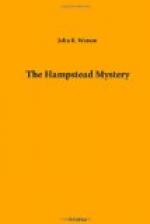“What are they?” asked Rolfe.
“In the first place the burglary was his idea, and not Birchill’s,” replied Crewe. “After the quarrel between Sir Horace and the girl Fanning, he went out to her flat and suggested to Birchill that he should rob Riversbrook. Hill’s real object in arranging this burglary was to get possession of the letters which Mrs. Holymead subsequently removed, but he did not tell Birchill this. His plan was to go to Riversbrook the morning after the burglary and then break open Sir Horace’s desk and open the secret drawer before informing the police of the burglary. To the police and Sir Horace it would look as though the burglar had accidentally found the spring of the secret drawer. With these letters in his possession Hill intended to blackmail Sir Horace, or Mrs. Holymead, without disclosing himself in the transaction.
“When Sir Horace returned unexpectedly from Scotland on the 18th of August, Hill had just removed the letters from the desk, being afraid that when Birchill broke into the house he might find them accidentally. He was naturally in a state of alarm at Sir Horace’s return. He tried to get an opportunity to put the letters back as Sir Horace might discover they had been removed, but Sir Horace dismissed him for the night before he could get such an opportunity. Then he went to Fanning’s flat and told Birchill that Sir Horace had returned. Birchill was in favour of postponing the burglary, but Hill, who had possession of the letters, and did not know when he would get an opportunity to put them back, urged Birchill to carry out the burglary. He assured Birchill that Sir Horace was a very sound sleeper and that there would be no risk. In order to arouse Birchill’s cupidity and to protect himself from the suspicions of Sir Horace regarding the letters, he told Birchill that he had seen a large sum of money in his possession when he returned, and that this money would probably be hidden in the secret drawer of the desk, until Sir Horace had an opportunity of banking it. He told Birchill to break open the desk, and explained to him how to find the spring of the secret drawer.”
“What a damned cunning scoundrel he is,” exclaimed Rolfe, in unwilling admiration of the completeness of Hill’s scheme. “Don’t you think, Mr. Crewe, that, after all, he may be the actual murderer—that he told you a lot of lies just as he did to us? Holymead in his address to the jury made out a pretty strong case against him.”
“No one knows better than Holymead that Hill did not commit the murder,” said Crewe. “Hill is an incorrigible liar, but he has no nerve for murder.”
“Did he put the letters back?” asked Rolfe. “He told me that Mrs. Holymead stole them the day after the murder was discovered. But he is such a liar—”
“I believe he spoke the truth in that case,” said Crewe. “He told me he put the letters back in the secret drawer the night after the murder, when he went to Riversbrook to report himself to Chippenfield. He put them back because he was afraid that if the police found them in his possession, they would think he had a hand in the murder. His idea was to remove them from the secret drawer after the excitement about the murder died down, and then blackmail Mrs. Holymead, but she acted with a skill and decision that robbed him of his chance to blackmail her.”




